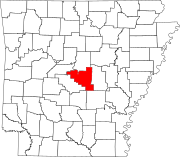College Station, Arkansas
College Station, Arkansas | |
|---|---|
 Location in Pulaski County and the state of Arkansas | |
| Coordinates: 34°42′30″N 92°13′43″W / 34.70833°N 92.22861°W | |
| Country | United States |
| State | Arkansas |
| County | Pulaski |
| Area | |
| • Total | 1.10 sq mi (2.86 km2) |
| • Land | 1.09 sq mi (2.83 km2) |
| • Water | 0.01 sq mi (0.02 km2) |
| Elevation | 318 ft (97 m) |
| Population (2020) | |
| • Total | 469 |
| • Density | 428.70/sq mi (165.47/km2) |
| Time zone | UTC-6 (Central (CST)) |
| • Summer (DST) | UTC-5 (CDT) |
| ZIP code | 72053 |
| Area code | 501 |
| FIPS code | 05-14860 |
| GNIS feature ID | 0057804 |
College Station is a census-designated place (CDP) in Pulaski County, Arkansas, United States. The population was 600 at the 2010 census.[2] It is part of the Little Rock–North Little Rock–Conway Metropolitan Statistical Area.
Geography[edit]
College Station is located at 34°42′30″N 92°13′43″W / 34.708292°N 92.228595°W.[3]
According to the United States Census Bureau, the CDP has a total area of 1.2 square miles (3.1 km2), all land.
Demographics[edit]
| Census | Pop. | Note | %± |
|---|---|---|---|
| 2000 | 766 | — | |
| 2010 | 600 | −21.7% | |
| 2020 | 469 | −21.8% | |
| U.S. Decennial Census[4] | |||
2020 census[edit]
| Race | Number | Percentage |
|---|---|---|
| White (non-Hispanic) | 15 | 3.2% |
| Black or African American (non-Hispanic) | 435 | 92.75% |
| Other/Mixed | 11 | 2.35% |
| Hispanic or Latino | 8 | 1.71% |
As of the 2020 United States census, there were 469 people, 167 households, and 142 families residing in the CDP.
2000 census[edit]
As of the census[6] of 2000, there were 766 people, 260 households, and 171 families residing in the CDP. The population density was 683.0 inhabitants per square mile (263.7/km2). There were 309 housing units at an average density of 275.5 per square mile (106.4/km2). The racial makeup of the CDP was 1.48% White, 95.78% Black or African American, 0.13% Native American, 0.78% Asian, and 1.83% from two or more races. 0.78% of the population were Hispanic or Latino of any race.
There were 260 households, out of which 23.1% had children under the age of 18 living with them, 26.5% were married couples living together, 32.7% had a female householder with no husband present, and 34.2% were non-families. 30.8% of all households were made up of individuals, and 10.4% had someone living alone who was 65 years of age or older. The average household size was 2.67 and the average family size was 3.43.
In the CDP, the population was spread out, with 23.9% under the age of 18, 10.1% from 18 to 24, 22.8% from 25 to 44, 24.9% from 45 to 64, and 18.3% who were 65 years of age or older. The median age was 40 years. For every 100 females, there were 95.4 males. For every 100 females age 18 and over, there were 87.5 males.
The median income for a household in the CDP was $14,191, and the median income for a family was $14,464. Males had a median income of $25,893 versus $17,000 for females. The per capita income for the CDP was $9,498. About 60.2% of families and 53.1% of the population were below the poverty line, including 76.3% of those under age 18 and 28.3% of those age 65 or over.
Education[edit]
It is within the Pulaski County Special School District.[7] It is zoned to College Station Elementary School (which serves students in kindergarten through grade five), Fuller Middle School, and Wilbur D. Mills University Studies High School.[8]
The Pulaski County SSD established a school in College Station. From 1949 to 1963, Otis Lee Walker was the principal of the school, which was central to the community of College Station. It was originally a single-room white frame building located in the main red-dirt road called Route 2 in Pulaski County. Route 2 is now known as Frazier Pike. Initially the school provided K-8 education, but during the 50s the higher grades of 7 and above were switched to Sweet Home, under the principalship of David Lyons who worked collaboratively with Otis Walker. Two additional frame buildings were added to the original location of the school providing for a cafeteria to accommodate school lunches and a space for school programs. A major fire of unknown origins destroyed much of the school during the late 1950s. The new facility was constructed at the current school location of 4710 Frazier Pike, Little Rock, Arkansas.
Shortly after court-mandated integration in the late 1960s, the black residents of College Station established a "boycott school" known as the Freedom School in protest of a busing plan. This school had an enrollment of 300, but existed for only two weeks.[9]
References[edit]
- ^ "2020 U.S. Gazetteer Files". United States Census Bureau. Retrieved October 29, 2021.
- ^ "U.S. Census website". U.S. Census Bureau. Retrieved April 26, 2011.
- ^ "US Gazetteer files: 2010, 2000, and 1990". United States Census Bureau. February 12, 2011. Retrieved April 23, 2011.
- ^ "Census of Population and Housing". Census.gov. Retrieved June 4, 2016.
- ^ "Explore Census Data". data.census.gov. Retrieved December 31, 2021.
- ^ "U.S. Census website". United States Census Bureau. Retrieved January 31, 2008.
- ^ "SCHOOL DISTRICT REFERENCE MAP (2010 CENSUS): Pulaski County, AR" (PDF). U.S. Census Bureau. Retrieved February 28, 2021.
- ^ "School Zone Map". Pulaski County Special School District. Archived from the original on January 18, 2021. Retrieved March 3, 2021.
- ^ "Private School Movement". Encyclopedia of Arkansas. Retrieved January 8, 2018.

